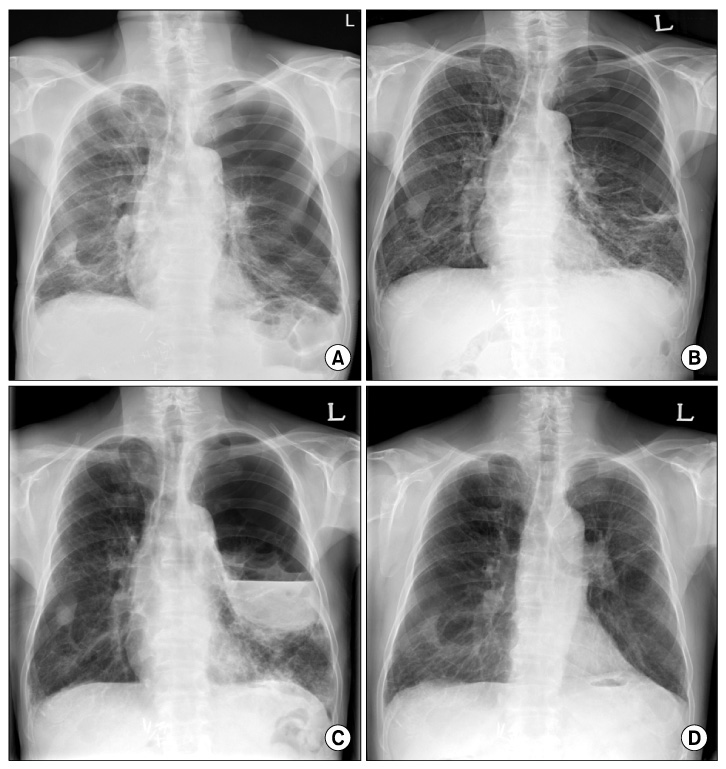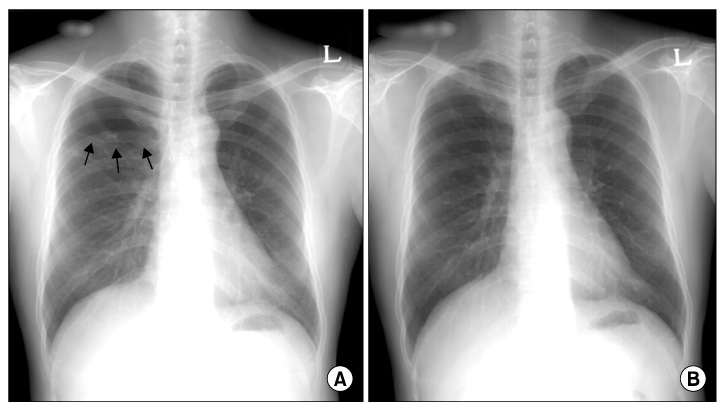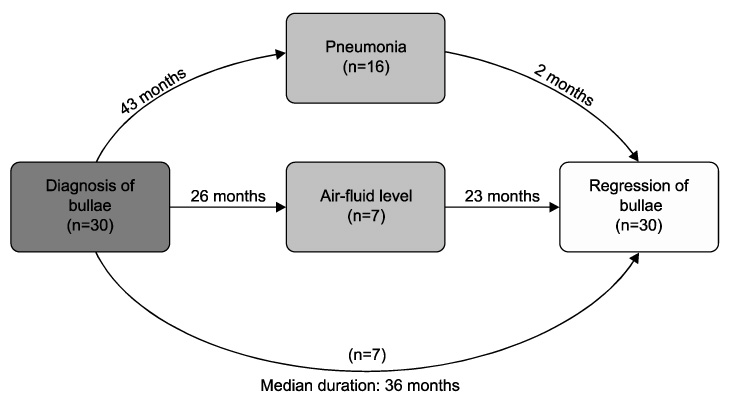Tuberc Respir Dis.
2012 Jan;72(1):37-43.
Regression of Large Lung Bullae after Peribullous Pneumonia or Spontaneously
- Affiliations
-
- 1Department of Pulmonary and Critical Care Medicine, Asan Medical Center, University of Ulsan College of Medicine, Seoul, Korea. wskim2@amc.seoul.kr
- 2Department of Internal Medicine, Yeungnam University College of Medicine, Daegu, Korea.
Abstract
- BACKGROUND
A lung bulla may rarely shrink as a result of an inflammation within the bulla or a closing of a bronchus involved in the inflammation process, which is termed 'autobullectomy'. The purpose of this study was to describe clinical features of patients with regressions of bullae during follow-up.
METHODS
We retrospectively reviewed the cases and individuals who showed unequivocal evidence of interval regressions in a pre-existing bulla. A total of 477 cases with a bulla >5 cm in diameter were screened manually. Thirty cases with bullae that showed regression during follow-up were selected.
RESULTS
Regressions of large bullae occurred in 30 of 477 cases (6.3%). The median age of those patients was 61 (range, 53~66) years and 87% of those patients were men. The main cause of a bulla was emphysema (80%). Among 30 cases, 16 cases had pneumonia in the lung parenchyma of the peribullous area. Another 7 cases had a regressed bulla accompanied by an air-fluid level within the bulla. The remaining 7 cases showed a spontaneous regression of the bulla without such events. Complete regression of a bulla occurred in 25 cases. A follow-up chest-X ray showed that in all cases except one, the bulla remained in a collapsed state after 24 months. Forced expiratory volume in one second (FEV1) improved in 3 cases and the other 2 cases had increased forced vital capacity (FVC). In addition, total lung capacity (TLC) and residual volume (RV) decreased in another 2 cases.
CONCLUSION
Regression of a lung bulla occurred not only after pneumonia or the presence of air-fluid level within the bulla, but also without such episodes. The clinical course of regression of a lung bulla varied. After regression of a bulla, lung function could be improved in some cases.
MeSH Terms
Figure
Reference
-
1. Wan IY, Toma TP, Geddes DM, Snell G, Williams T, Venuta F, et al. Bronchoscopic lung volume reduction for end-stage emphysema: report on the first 98 patients. Chest. 2006. 129:518–526.2. Noppen M, Tellings JC, Dekeukeleire T, Dieriks B, Hanon S, D'Haese J, et al. Successful treatment of a giant emphysematous bulla by bronchoscopic placement of endobronchial valves. Chest. 2006. 130:1563–1565.3. Criner GJ, Belt P, Sternberg AL, Mosenifar Z, Make BJ, Utz JP, et al. Effects of lung volume reduction surgery on gas exchange and breathing pattern during maximum exercise. Chest. 2009. 135:1268–1279.4. Orton DF, Gurney JW. Spontaneous reduction in size of bullae (autobullectomy). J Thorac Imaging. 1999. 14:118–121.5. Miller WC, Unger KM, Suich DM. Autobullectomy. Chest. 1991. 100:294.6. Douglas AC, Grant IW. Spontaneous closure of large pulmonary bullae: a report on three cases. Br J Tuberc Dis Chest. 1957. 51:335–338.7. Bonay M, Debray MP. Rapid improvement in pulmonary function after inflammatory autobullectomy. Eur J Intern Med. 2008. 19:e99–e100.8. al-Majed SA. Replacement of one lung by a large bulla in active tuberculosis. Thorax. 1995. 50:427–428.9. Bradshaw DA, Murray KM, Amundson DE. Spontaneous regression of a giant pulmonary bulla. Thorax. 1996. 51:549–550.10. Alarcon DG. Regressive giant bullous emphysema in tuberculosis of adults. Dis Chest. 1955. 27:31–43.11. Rothstein E, Moberly JW. Emphysematous bullae and pulmonary tuberculosis. Dis Chest. 1952. 22:587–597.12. Chandra D, Rose SR, Carter RB, Musher DM, Hamill RJ. Fluid-containing emphysematous bullae: a spectrum of illness. Eur Respir J. 2008. 32:303–306.13. Bhattacharyya P, Sarkar D, Nag S, Ghosh S, Roychoudhury S. Transbronchial decompression of emphysematous bullae: a new therapeutic approach. Eur Respir J. 2007. 29:1003–1006.14. Satoh H, Suyama T, Yamashita YT, Ohtsuka M, Sekizawa K. Spontaneous regression of multiple emphysematous bullae. Can Respir J. 1999. 6:458–460.15. Palla A, Desideri M, Rossi G, Bardi G, Mazzantini D, Mussi A, et al. Elective surgery for giant bullous emphysema: a 5-year clinical and functional follow-up. Chest. 2005. 128:2043–2050.16. Wood DE, McKenna RJ Jr, Yusen RD, Sterman DH, Ost DE, Springmeyer SC, et al. A multicenter trial of an intrabronchial valve for treatment of severe emphysema. J Thorac Cardiovasc Surg. 2007. 133:65–73.17. Kanoh S, Kobayashi H, Motoyoshi K. Intrabullous blood injection for lung volume reduction. Thorax. 2008. 63:564–565.18. Ingenito EP, Berger RL, Henderson AC, Reilly JJ, Tsai L, Hoffman A. Bronchoscopic lung volume reduction using tissue engineering principles. Am J Respir Crit Care Med. 2003. 167:771–778.
- Full Text Links
- Actions
-
Cited
- CITED
-
- Close
- Share
- Similar articles
-
- Expeditious Resolution of Giant Bullae with Endobronchial Valves and Percutaneous Catheter Insertion
- A unilateral large bronchopleural fistula caused by rupture of bulla with coexisting bilateral giant bullae: A case report
- A Case of Spontaneously Regressed Endobronchial Sarcoma after Obstructive Pneumonia
- A case of bullous lung disease disappeared spontaneously
- Idiopathic Interstitial Pneumonias: Radiologic Findings




